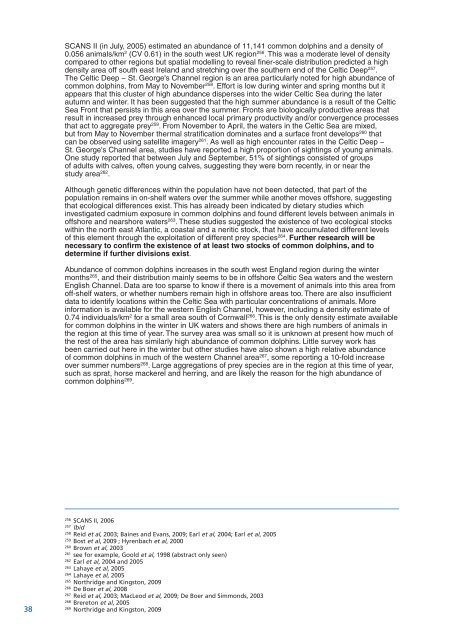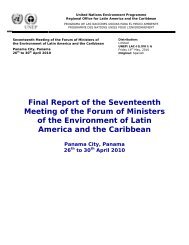SCANS II (in July, 2005) estimated an abundance of 11,141 common dolphins and a density of0.056 animals/km 2 (CV 0.61) in the south west UK region 256 . This was a moderate level of densitycompared to other regions but spatial modelling to reveal finer-scale distribution predicted a highdensity area off south east Ireland and stretching over the southern end of the Celtic Deep 257 .The Celtic Deep − St. George's Channel region is an area particularly noted for high abundance ofcommon dolphins, from May to November 258 . Effort is low during winter and spring months but itappears that this cluster of high abundance disperses into the wider Celtic Sea during the laterautumn and winter. It has been suggested that the high summer abundance is a result of the CelticSea Front that persists in this area over the summer. Fronts are biologically productive areas thatresult in increased prey through enhanced local primary productivity and/or convergence processesthat act to aggregate prey 259 . From November to April, the waters in the Celtic Sea are mixed,but from May to November thermal stratification dominates and a surface front develops 260 thatcan be observed using satellite imagery 261 . As well as high encounter rates in the Celtic Deep −St. George's Channel area, studies have reported a high proportion of sightings of young animals.One study reported that between July and September, 51% of sightings consisted of groupsof adults with calves, often young calves, suggesting they were born recently, in or near thestudy area 262 .Although genetic differences within the population have not been detected, that part of thepopulation remains in on-shelf waters over the summer while another moves offshore, suggestingthat ecological differences exist. This has already been indicated by dietary studies whichinvestigated cadmium exposure in common dolphins and found different levels between animals inoffshore and nearshore waters 263 . These studies suggested the existence of two ecological stockswithin the north east Atlantic, a coastal and a neritic stock, that have accumulated different levelsof this element through the exploitation of different prey species 264 . Further research will benecessary to confirm the existence of at least two stocks of common dolphins, and todetermine if further divisions exist.Abundance of common dolphins increases in the south west England region during the wintermonths 265 , and their distribution mainly seems to be in offshore Celtic Sea waters and the western<strong>English</strong> Channel. Data are too sparse to know if there is a movement of animals into this area fromoff-shelf waters, or whether numbers remain high in offshore areas too. There are also insufficientdata to identify locations within the Celtic Sea with particular concentrations of animals. Moreinformation is available for the western <strong>English</strong> Channel, however, including a density estimate of0.74 individuals/km 2 for a small area south of Cornwall 266 . This is the only density estimate availablefor common dolphins in the winter in UK waters and shows there are high numbers of animals inthe region at this time of year. The survey area was small so it is unknown at present how much ofthe rest of the area has similarly high abundance of common dolphins. Little survey work hasbeen carried out here in the winter but other studies have also shown a high relative abundanceof common dolphins in much of the western Channel area 267 , some reporting a 10-fold increaseover summer numbers 268 . Large aggregations of prey species are in the region at this time of year,such as sprat, horse mackerel and herring, and are likely the reason for the high abundance ofcommon dolphins 269 .38256SCANS II, 2006257Ibid258Reid et al, 2003; Baines and Evans, 2009; Earl et al, 2004; Earl et al, 2005259Bost et al, 2009 ; Hyrenbach et al, 2000260Brown et al, 2003261see for example, Goold et al, 1998 (abstract only seen)262Earl et al, 2004 and 2005263Lahaye et al, 2005264Lahaye et al, 2005265Northridge and Kingston, 2009266De Boer et al, 2008267Reid et al, 2003; MacLeod et al, 2009; De Boer and Simmonds, 2003268Brereton et al, 2005269Northridge and Kingston, 2009
4.4.4 COMMON MINKE WHALE (Balaenoptera acutorostrata)Minke whale sightings are frequent and widespread from May to October in UK waters. The generalpattern appears to be an increased use of coastal areas as the season progresses, peaking July toSeptember when large feeding aggregations can be observed in coastal waters 270 . Outside thesemonths sightings are fewer and little is known about their winter distribution. Some individuals atleast remain close to the UK and Ireland 271 but for the majority, it is unclear if they undergo alatitudinal migration or simply move further offshore for the winter months. In some locations aroundthe UK at least, photo-ID studies have found individuals to be resident seasonally 272 , or possiblyyear round 273 .Sandeels, herring and sprat (Sprattus sprattus) have been noted as principal prey items of minkewhales in British waters 274 but other fish species, such as mackerel, cod and capelin (Mallotusvillosus), are also eaten 275 . Minke whale distribution and abundance during the summer feedingseason, partly spent in UK waters, ultimately depends on prey distribution and abundance 276 .Minke whales are often noted feeding in association with seabirds, including kittiwakes, gullsand shearwaters 277 .The first SCANS survey of 1994 produced an estimate of 8,445 (95% CI = 4,987-13,546; CV =0.24) for minke whales in the North Sea. SCANS II (in July, 2005) resulted in an estimate of 10,541(CV = 0.32) for the same area but this difference was not significant 278 . The CODA offshorecetacean survey produced an estimated abundance of 6,765 (95% CI = 1,239-36,925; CV = 0.99)for minke whales, with sightings restricted to the northern blocks of the survey area, in UK andIrish offshore waters. Figures 4.17 (below), 4.19 (p.40) and 4.21 (p.41) display density estimatesproduced by SCANS, SCANS II and CODA respectively. Figures 4.18 (below) and 4.20 (p.40) showthe estimated density surfaces produced using SCANS and SCANS II data 279 .270Evans et al, 2003; Northridge et al, 1995; Reid et al, 2003; Macleod et al, 2007271Anderwald and Evans, 2007; Gill et al, 2000272Gill et al, 2000273MacLeod et al, 2004274Pierce et al, 2004; Macleod et al, 2004; Anderwald and Evans, 2007275Reid et al, 2003; Anderwald and Evans, 2007276MacLeod et al, 2004;277Robinson and Tetley, 2007; Skov et al, 1995; Reid et al, 2003278SCANS II, 2006279Reproduced with permission. SCANS II, 2006. Please note that density surface maps show estimated densityderived from a spatial model and should not be overinterpreted, particularly at a fine spatial scale.39
- Page 1 and 2: WDCS, the Whale and Dolphin Conserv
- Page 3 and 4: Towards Marine ProtectedAreas for C
- Page 5 and 6: South west EnglandCeltic Deep - com
- Page 7 and 8: CONTENTSExecutive Summary 2Acknowle
- Page 9 and 10: 1. INTRODUCTIONWe enter an exciting
- Page 11 and 12: Note: This schematic map shows thev
- Page 13 and 14: 2. IDENTIFYING MARINE PROTECTED ARE
- Page 15 and 16: 3. CRITICAL HABITATInterest in the
- Page 17 and 18: Foraging, travel, socialising and p
- Page 19 and 20: 4. DATA AND SPECIES ACCOUNTSIn orde
- Page 21 and 22: Killer whale (Orcinus orca)Atlantic
- Page 23 and 24: 4.4 SPECIES ACCOUNTS4.4.1 HARBOUR P
- Page 25 and 26: Although there is some variation in
- Page 27 and 28: North ScotlandThe first SCANS surve
- Page 29 and 30: East EnglandThe seasonal pattern in
- Page 31 and 32: Irish SeaOutside of coastal Welsh w
- Page 33 and 34: 4.4.2 BOTTLENOSE DOLPHIN (Tursiops
- Page 35 and 36: This expansion in range means this
- Page 37 and 38: 4.4.3 SHORTBEAKED COMMON DOLPHIN (D
- Page 39: South west EnglandBased on observat
- Page 43 and 44: Sightings for this area of the Oute
- Page 45 and 46: The JNCC Atlas of cetacean distribu
- Page 47 and 48: 4.4.5 WHITEBEAKED DOLPHIN (Lagenorh
- Page 49 and 50: 4.4.6 RISSO'S DOLPHIN (Grampus gris
- Page 51 and 52: 4.4.7 KILLER WHALE OR ORCA (Orcinus
- Page 53 and 54: 4.4.8 ATLANTIC WHITESIDED DOLPHIN (
- Page 55 and 56: 4.4.9 LONGFINNED PILOT WHALE (Globi
- Page 57 and 58: 4.4.10 SPERM WHALE (Physeter macroc
- Page 59 and 60: 4.4.11 BEAKED WHALESNORTHERN BOTTLE
- Page 61 and 62: which looked at worldwide beaked wh
- Page 63 and 64: There is no current population esti
- Page 65 and 66: 4.5 SCOTTISH MPA GUIDELINES - STAGE
- Page 67 and 68: Northern bottlenose whale and Sower
- Page 69 and 70: Fisheries BycatchFisheries bycatch
- Page 71 and 72: 5.2 AN OVERVIEW OF REGIONAL THREATS
- Page 73 and 74: North ScotlandAs in the west, threa
- Page 75 and 76: 6. IDENTIFYING CRITICAL HABITAT IN
- Page 77 and 78: 6.1.1 HARBOUR PORPOISEWest and sout
- Page 79 and 80: Assessment: Critical HabitatHigh re
- Page 81 and 82: 11. Area: Off Land's End, Cornwall
- Page 83 and 84: Threats, status and relative import
- Page 85 and 86: East Scotland3. Area: North east Sc
- Page 87 and 88: Threats, status and relative import
- Page 89 and 90: 6.1.4 COMMON MINKE WHALEWest and so
- Page 91 and 92:
6.1.5 WHITEBEAKED DOLPHINWest and s
- Page 93 and 94:
Coastal Wales2. Area: Bardsey Islan
- Page 95 and 96:
6.1.8 ATLANTIC WHITESIDED DOLPHINNo
- Page 97 and 98:
Other areasOne other area was asses
- Page 99 and 100:
6.1.11 BEAKED WHALESThe northern Ro
- Page 101 and 102:
7. PROTECTING CRITICAL HABITAT - RE
- Page 103 and 104:
considered in the area, each of whi
- Page 105 and 106:
7.4 EAST SCOTLANDWithin the east Sc
- Page 107 and 108:
7.5 SOUTH WEST ENGLANDWithin the so
- Page 109 and 110:
An SAC is already in place for bott
- Page 111 and 112:
7.9 SUMMARYFour areas of identified
- Page 113 and 114:
iv. Licensing processes for industr
- Page 115 and 116:
9. IDENTIFICATION AND PRIORITISATIO
- Page 117 and 118:
Recommendations on particular data
- Page 119 and 120:
Coastal Wales northern Pembrokeshir
- Page 121 and 122:
ANNEX II SPECIES ACCOUNTS SUMMARY
- Page 123 and 124:
HARBOUR PORPOISEEast ScotlandStudyH
- Page 125 and 126:
HARBOUR PORPOISESouth West EnglandS
- Page 127 and 128:
HARBOUR PORPOISECoastal WalesStudyT
- Page 129 and 130:
BOTTLENOSE DOLPHINStudyTemporalReso
- Page 131 and 132:
SHORTBEAKED COMMON DOLPHINStudyTemp
- Page 133 and 134:
SHORTBEAKED COMMON DOLPHINStudyTemp
- Page 135 and 136:
COMMON MINKE WHALEWest ScotlandStud
- Page 137 and 138:
WHITEBEAKED DOLPHINStudyTemporalRes
- Page 139 and 140:
KILLER WHALEStudyTemporalResolution
- Page 141 and 142:
ATLANTIC WHITESIDED DOLPHINStudyTem
- Page 143 and 144:
SPERM WHALEStudyTemporalResolutionS
- Page 145 and 146:
BALEEN WHALESStudyTemporalResolutio
- Page 147 and 148:
ANNEX III THREATS TO CETACEANS - RE
- Page 149 and 150:
Actual orPotential ThreatActivitySp
- Page 151:
North ScotlandSpecies of most relev
- Page 156 and 157:
East EnglandSpecies of most relevan
- Page 158 and 159:
South East EnglandSpecies of most r
- Page 160 and 161:
South West EnglandSpecies of most r
- Page 162 and 163:
Irish SeaSpecies of most relevance
- Page 164 and 165:
Actual orPotential ThreatActivitySp
- Page 166 and 167:
Bravington, M., Borchers, D. and No
- Page 168 and 169:
Evans, P.G.H. and Anderwald, P. 200
- Page 170 and 171:
ICES WGMME. 2006. Report of the Wor
- Page 172 and 173:
ECS/ASCOBANS/ACCOBAMS Workshop held
- Page 174 and 175:
marine protected areas effective to
- Page 176:
ISBN: 9781901386233
















